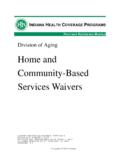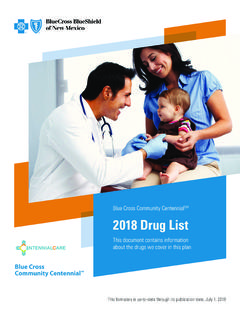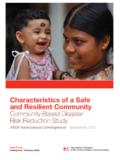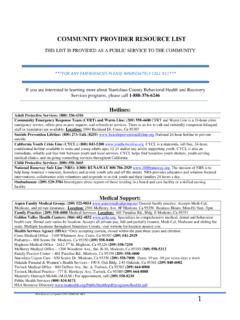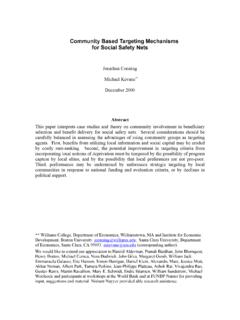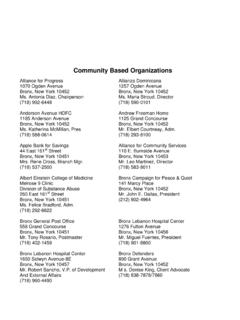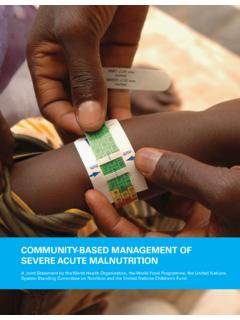Transcription of Community-Based Health Needs Assessment …
1 Community-Based Health Needs Assessment Activities: Opportunities for Collaboration Between Public Health Departments and Rural Hospitals Executive Summary Since the passage of IRS and Public Health Accreditation Board requirements for Community-Based Health assessments in 2011, state and federal agencies have sought ways of encouraging collaboration between local public Health departments and rural hospitals. This document explores the framework and regulatory background that have informed how and why rural communities approach community - based Health Needs assessments. It also looks at opportunities and barriers that local public Health departments and rural hospitals face in their attempts to work collaboratively on projects.
2 By scanning models from across the country, the authors are able to explore areas of education and collaboration, funding, and data sharing as opportunities for increased collaboration. Lastly, the scan provides several recommendations for how state offices of rural Health and state Health officials can work collaboratively to encourage local public Health departments and rural hospitals to complete joint Community-Based Health Needs assessments. Introduction Developing Community-Based Health Needs assessments (CHNAs) has been a cornerstone of local Health and human service planning for decades. However, this process was voluntary until IRS released its CHNA requirements for nonprofit hospitals and the Public Health Accreditation Board added CHNAs to its accreditation requirements for Health departments.
3 The authors developed this scan at HRSA's request to provide background information and recommendations on CHNAs in rural communities. This document aims to foster dialogue and collaboration on data sharing and CHNAs among rural and public Health leaders. For the purpose of this scan, the term Community-Based Health Needs Assessment is broadly defined according to CDC's definition of a process of community engagement; collection, analysis, and interpretation of data on Health outcomes and Health correlates/determinants; identification of Health disparities; and identification of resources that can be used to address priority Needs . 1 Although much of the literature discusses CHNAs" and community Health assessments (CHAs) interchangeably, for this scan the authors identify CHNAs as the documents that hospitals must develop to meet IRS.
4 Nonprofit status requirements, while referring to CHAs as the assessments that public Health departments must conduct in order to seek accreditation status. This scan provides background information on two major policies affecting Needs assessments: requirements for nonprofit hospitals under federal tax law, and requirements for accredited public Health departments as part of their accreditation process. It also covers examples of how states have been planned, conducted, and utilized CHNAs. At the end of the document, we have provided a list of resources and recommendations for policymakers, state offices of rural Health directors, state Health officers, local public Health departments, rural hospitals, and other community planners.
5 Association of State and Territorial Health Officials 2017 2231 Crystal Drive, Suite 450, Arlington, VA. 202-371-9090 Acknowledgments Under a subcontract with ASTHO, the National Organization of State Offices of Rural Health (NOSORH). has reviewed the work of a selection of state offices of rural Health (SORH). NOSORH queried SORHs and their partners on their Community-Based Health Needs assessments activities, data sharing efforts, and other collaborative efforts that contributed to meaningful assessments and planning for rural communities. NOSORH thanks the SORHs, partners, and leaders who shared their work, provided insight, and reviewed the scan, including: Margaret Brockman, Director, Nebraska Office of Rural Health , Nebraska Department of Health and Human Services.
6 Lara Brooks, Rural Health Analyst, Oklahoma Office of Rural Health , Oklahoma State University Center for Health Sciences. Natalie Claiborne, Assistant Director, Montana Office of Rural Health and Area Health Education Center, Montana State University. Joyce Hospodar, Senior Advisor, Arizona Center for Rural Health , Mel & Enid Zuckerman College of Public Health , University of Arizona. Karen Madden, Director, New York Office of Rural Health , New York Department of Health . Michael Meit, Senior Fellow, NORC Walsh Policy Center for Rural Analysis. Megan Miller, Senior Director, Health Integration, ASTHO. Background In the 1980s, Health organizations began developing community engagement documents and initiatives, termed community appraisals, in response to the rigidity of traditional epidemiological models and survey questionnaires.
7 Several iterations of the models became popular, including rapid evaluation methods, rapid appraisal methods, rapid community surveys, participatory rural appraisal, and relaxed rural appraisal. One study found that when [ community appraisals] were perfectly executed, they provided valuable, reliable and timely information on Health status, knowledge, attitudes, and behaviors. 2. Over the last 15 years, two major changes have directly affected states' and localities' Needs Assessment activities. In 2011, the Public Health Accreditation Board (PHAB) adopted policies to establish a national system of public Health accreditation. Additionally, after the policy changes provided by Public Law 111- 148, the IRS modified the Internal Revenue Code in 2010 to require tax-exempt hospitals to provide proof of community engagement.
8 The table below provides an overview of the regulatory timelines and policy changes regarding Community-Based Health assessments. Timeline of Regulatory and Policy Changes Relevant to Hospitals and Public Health Department Assessments Year Event Affected Entities 2003 Institute of Medicine publishes The Future of the Public's Public Health departments Health report discussing public Health department accreditation. Association of State and Territorial Health Officials 2017 2231 Crystal Drive, Suite 450, Arlington, VA. 202-371-9090 2004 CDC publicly supports public Health department accreditation. Public Health departments 2005 Robert Wood Johnson Foundation participates in public Health Public Health departments department accreditation knowledge gathering.
9 2007 PHAB launches national standards for public Health Public Health departments department accreditation. 2010 IRS proposes new CHNA policies for nonprofit hospitals. Hospitals 2011 PHAB adopts CHNA accreditation policies. Hospitals 2014 IRS publishes final rules requiring nonprofit hospitals to prove Hospitals community engagement. Public Health Accreditation Board Policies In 2003, the Institute of Medicine published its report The Future of the Public's Health , which initially called for a steering committee to examine the potential benefits of accrediting public Health In 2004, CDC identified accreditation as a key strategy. With the assistance of the Robert Wood Johnson Foundation, a workgroup of stakeholders convened for the Exploring Accreditation project in 2005, and PHAB launched in May 2007.
10 After developing, testing, and revising the accreditation standards, PHAB launched its national public Health accreditation program in September IRS Policies Prior to the adoption of Public Law 111-148, nonprofit hospitals had to justify their nonprofit, tax- exempt status by showing that they provided a public benefit. Shortly after the IRS implemented its new community Needs Assessment requirements in March 2010, Health leaders and policymakers recognized that states and localities had already developed a wide range of Community-Based Health Needs assessments. In some rural communities, hospitals and local Health departments conducted similar surveys of the same people, analyzed data without the benefit of each organization's access to different types of data, and sometimes planned duplicative or competing program activities for the same The narrative below highlights aspects of the PHAB and IRS policies, discusses the overlap between the requirements, and identifies barriers to collaboration.



